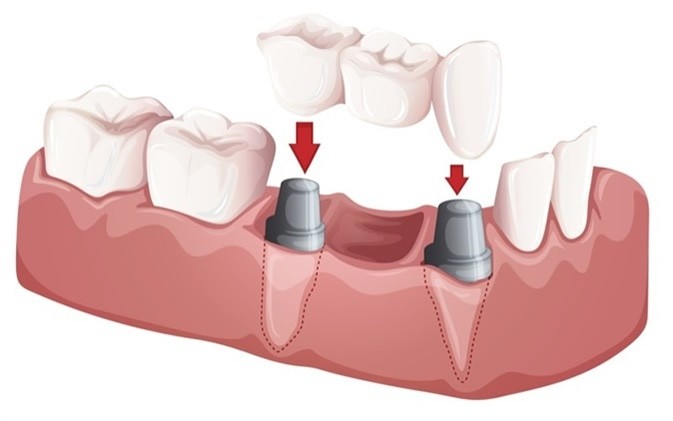Losing a tooth can impact more than just your smile. It can affect your ability to chew, speak clearly, and even the shape of your face. A dental bridge offers a reliable solution to fill those gaps and restore both function and aesthetics. This article will explain what a dental bridge is, the different types available, and what to expect during the procedure.
Understanding Dental Bridges: Closing the Gap
A dental bridge is essentially a false tooth, known as a pontic, that is used to “bridge” the gap created by one or more missing teeth. To hold this pontic in place, it is anchored to the adjacent healthy teeth on either side of the gap. These supporting teeth are called abutment teeth.
In most traditional dental bridges, the abutment teeth are prepared to receive dental crowns. These crowns act as anchors, securely holding the pontic in place and creating a seamless restoration. The pontic itself can be made from various durable and natural-looking materials such as porcelain, gold, alloys, or a combination of these.
 Diagram illustrating a dental bridge, showing the pontic tooth filling the gap between two crowned abutment teeth, a common solution for missing teeth.
Diagram illustrating a dental bridge, showing the pontic tooth filling the gap between two crowned abutment teeth, a common solution for missing teeth.
Why Choose a Dental Bridge? Benefits Beyond Aesthetics
Dental bridges offer a multitude of benefits for individuals experiencing tooth loss. They are not just about improving your smile’s appearance; they play a crucial role in your overall oral health and well-being:
- Restores your smile: A missing tooth can make you self-conscious. Bridges effectively fill the gap, giving you back a complete and confident smile.
- Maintains facial shape: Teeth support the structure of your face. Missing teeth can lead to facial sagging over time. Bridges help maintain your natural facial contours.
- Prevents teeth shifting: Gaps from missing teeth can cause adjacent teeth to drift out of position, leading to bite problems and potential further tooth loss. Bridges hold your remaining teeth in place.
- Improves chewing and speaking: Missing teeth can make it difficult to chew properly and pronounce certain words. Bridges restore your ability to eat a wider range of foods and speak clearly.
- Distributes bite force: Missing teeth can unevenly distribute the pressure when you bite, potentially damaging remaining teeth and jaw joints. Bridges help to redistribute bite forces evenly across your mouth.
Types of Dental Bridges: Choosing the Right Fit
There are several types of dental bridges, and the best option for you will depend on the location of the missing tooth or teeth and the condition of your surrounding teeth:
- Traditional Fixed Bridges: This is the most common type. It involves creating a pontic that is held in place by dental crowns cemented onto the abutment teeth on each side of the gap.
- Cantilever Bridges: Used when there are adjacent teeth on only one side of the missing tooth. In this case, the pontic is supported by a crown cemented to just one abutment tooth. This type is less common and requires strong abutment teeth.
- Maryland Bonded Bridges (Resin-bonded bridges): Often used for replacing front teeth. These bridges consist of a pontic made of porcelain or porcelain fused to metal, which is supported by a metal or porcelain framework. This framework is bonded to the back surfaces of the abutment teeth, requiring less alteration to the adjacent teeth compared to traditional bridges.
The Dental Bridge Procedure: What to Expect
Getting a dental bridge typically involves a few appointments with your dentist:
- Preparation of Abutment Teeth: The abutment teeth need to be reshaped so that crowns can properly fit over them. This involves removing a portion of the enamel and dentin.
- Impressions: After preparation, impressions of your teeth are taken. These impressions are sent to a dental laboratory where the bridge, pontic, and crowns will be custom-made to fit your mouth precisely.
- Temporary Bridge: While your permanent bridge is being fabricated, a temporary bridge may be placed to protect the prepared abutment teeth and maintain aesthetics.
- Bridge Fitting and Cementation: At your next appointment, the permanent bridge is fitted. Your dentist will check the fit and your bite. Once the fit is satisfactory, the bridge is cemented into place, usually starting with temporary cement to ensure comfort and proper function before using permanent cement.
Maintaining Your Dental Bridge: Ensuring Longevity
With proper care, a dental bridge can last for many years, often exceeding 10 years or more. The key to durability lies in maintaining excellent oral hygiene and regular dental check-ups:
- Brush twice daily: Brush your teeth twice a day using fluoride toothpaste, paying special attention to the area around the bridge.
- Floss daily: Flossing is crucial to clean under and around the bridge where a regular toothbrush cannot reach. Your dentist may recommend special floss threaders or interdental brushes to clean effectively around your bridge.
- Regular dental check-ups and cleanings: Visit your dentist for regular check-ups and professional cleanings. These appointments allow your dentist to monitor the health of your bridge and supporting teeth and address any potential issues early on.
- Dietary Considerations: While bridges are strong, be cautious with very hard or sticky foods that could potentially damage or dislodge the bridge.
Dental bridges are a well-established and effective solution for replacing missing teeth, offering both functional and cosmetic benefits. If you are considering a dental bridge, consult with your dentist to discuss your individual needs and determine if a dental bridge is the right option for you to restore your smile and confidence.
References
- Original article content and structure were used as a reference for factual information and topic coverage.
Further Reading
- Consult your dentist for personalized advice and information.
- American Dental Association – Bridges (Example – Replace with actual reputable source if needed for a real article)

